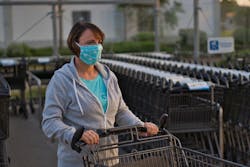The Centers for Disease Control and Prevention (CDC) crafted a detailed document to guide states on the reopening of retail, daycares, schools and religious services, among other things, but that report was quickly shelved the Associated Press reported.
The 17-page document, "Guidance for Implementing the Opening Up of America Again Framework," was supposed to be published on May 1, the day the 45-day federal social distancing campaign expired across the country. A CDC scientist who spoke to reporters on the condition of anonymity said the agency was told the report would never see the light of day.
The document asks users to use "decision trees," or a series of questions about the condition of reopening that loosely follow the three-phase guidelines for business reopening. For every camp, school, place of worship, or day care center, reopening cannot be considered until the community is not requiring significant mitigation to reduce the spread of COVID-19.
The Washington Post reports that the guidelines were found to be overly specific and said rural communities should not have to meet the same standards as major cities who have faced larger COVID-19 outbreaks.
According to the New York Times COVID-19 tracker, the United States now has over 1,250,000 cases and more than 75,000 deaths.
As more states open up, with many doing so even as case counts increase, the Columbia University Mailman School of Public Health released new modeling that shows a spike in rebound cases projected for late May. In the last week, 25 states have partially opened their economies.
"In all but two of the 25 states that already have or plan to partially re-open their economies in the coming week," the modelers write, "the data model projects substantial increases in COVID-19 cases based on either of two scenarios: (1) a one-time 10 percent increase to the contact rate during the week that the state is scheduled to reopen and (2) a weekly 10 percent increase in contact rates, which represent a progressive loosening of restrictions and increased public confidence and frequenting of businesses."
The rebound will likely happen two to four weeks after states reopen, according to the experts.
"The lag between infection acquisition and case confirmation, coupled with insufficient testing and contact tracing, will mask any rebound and exponential growth of COVID-19 until it is well underway," says lead researcher Jeffrey Shaman, PhD, professor of environmental health sciences, in a press release.
The Atlanta-Journal Constitution published a report concerning a spike in cases as Georgia reopens. Unless residents still act as though on lockdown, the state could see New York–like numbers by July, according to mathematical models.
Harvard's Global Health Institute proposed that the country should be conducting more than 900,000 tests per day as a country in order to reopen safety. In the last week, the nation has conducted roughly 248,000 tests daily.
By March, the vast majority cases of COVID-19 in the United States could be traced back to New York City, which in turn could trace cases back to Europe, according to new research published in the New York Times.
Using genetic analysis of the virus, scientists at the Yale School of Public Health said they are confident New York acted as the primary gateway for the rest of country, with 88 percent of cases in Ohio and 100 percent in Louisiana and Iowa genetically linked to strains from New York. The researchers said that the vast majority of current COVID-19 cases are linked to domestic, and not international spread in this country.
New York Governor Andrew Cuomo said most New Yorkers hospitalized with the coronavirus in recent days were not working and had been living in their homes, the Wall Street Journal reports.
A survey of 1,269 COVID-19 patients at 113 hospitals found that only 17 percent were working, compared with 37 percent who were retired and 46 percent who were unemployed, and 66 percent were in their homes before being admitted to the hospital. This indicates family or household spread, a phenomenon also seen in Italy's lockdown.
In related news, the Infectious Diseases Society of America and the HIV Medicine Association called for more transparency about how and when the experimental antiviral remdesivir is being distributed in the United States.
In a letter, the groups write, "The plan for distributing remdesivir should be transparent and should be based on state and regional COVID-19 case data and hospitalization rates. Supplies of remdesivir should be distributed on a regional basis with equitable distribution within the region to states and within states to hospitals."
Within the last week, the U.S. Food and Drug Administration issued an Emergency Use Authorization application for remdesivir.
Stat News reported that physicians are growing impatient at the lack of access to the drug, which they say is being distributed to about two dozen hospitals across the country. They said the selection process for those hospitals has not been made clear.

